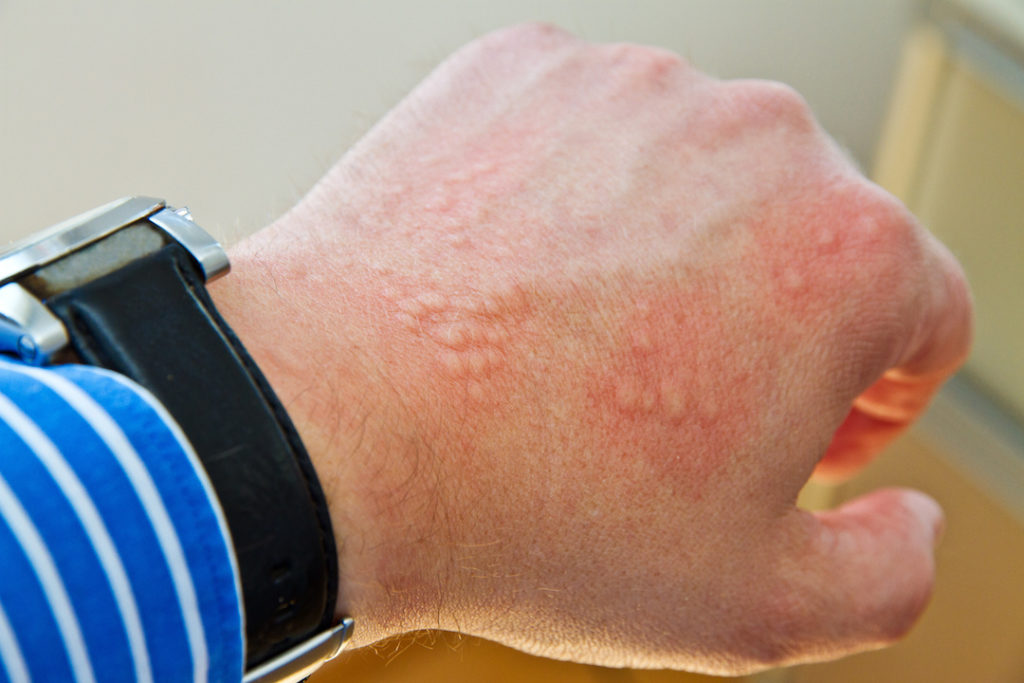5 Causes of Hives You Wouldn’t Expect
December 3 2018
Breaking out in hives is the worst: your skin itches all over, you’re covered in unsightly red welts, and, as if that weren’t bad enough, it’s not always clear what might have triggered them.
What we do know: hives, also known as urticaria, can appear anywhere on the body, including your face, torso, arms, legs, and even inside your mouth and ears. They may range in size from as tiny as a pencil tip to as large as a dinner plate. Hives typically crop up when you have an allergic reaction to a substance—pet dander, pollen, latex—triggering your body to release histamine and other chemicals into your blood. That’s what causes the itching, swelling, and other symptoms.
Whether someone falls into the category of acute hives (lasting six weeks or less) or chronic hives (more than six weeks), there are a few concrete causes of those pesky red bumps:
Your diet
If you tend to break out in hives after eating shellfish, peanuts, tree nuts, eggs, milk, and berries, then you may have a food allergy, says Debra Jaliman, MD, a New York City-based dermatologist and the author of Skin Rules.
For some, the culprit is obvious—they’ll eat a peanut butter cookie, for example, and immediately break out in a rash. For others, it’s not so cut and dry; symptoms can take several hours to develop. Either way, make an appointment with your doctor if you suspect you have a food allergy. Dr. Jaliman says you’ll likely be put on an elimination diet where you reintroduce one potentially triggering food every week. “Let’s say you’re not eating any of the hives foods and then you add back shellfish and you get the hives again. Then you can pretty much figure it out,” Dr. Jaliman says. After you determine the culprit, nix it from your diet to prevent mild symptoms from becoming chronic. Dr. Jaliman says you’ll likely be prescribed an EpiPen—if you accidentally ingest a trigger food, you could get hives in your throat, which can be dangerous.
The great outdoors
Insect bites and exposure to pollen can make you break out in hives, but you probably already knew that. What you may not have realised is that direct sunlight, cold temperatures, or strong winds can also bring on hives. And no, this doesn’t mean you’re allergic to the elements. “It’s really more that your skin is very sensitive,” says Marilyn Li, MD, a Los Angeles-based allergist and immunologist.
While avoiding these triggers could prevent hives from returning, Dr. Li says your doctor may be able to provide an antihistamine that could solve a weather- or temperature-based problem. That way, you can enjoy a hike on a sunny summer day or hold a cold can of beer on the weekend without worrying about a potential hives outbreak.
An underlying illness
Chronic hives can be a telltale sign of a larger problem, and extensive blood work may be necessary to pinpoint the underlying issue. Dr. Jaliman says patients with lupus, lymphoma, thyroid disease, hepatitis, or HIV may have hives as a symptom of their illness. Since these people tend to suffer from chronic hives, medications are the most reliable form of relief.
If you’ve contracted a virus, that could be a cause for hives as well. Dr. Li says hives caused by viruses typically last for six weeks, so if your rash persists for longer, see an allergist to determine another possible cause.
Your daily sweat session
While your morning jog or post-work weightlifting regimen can boost endorphins, your daily dose of exercise could also be causing you to break out in hives. Why? According to Dr. Jaliman, the body produces acetylcholine, a chemical that can inhibit cell breakdown, as a response to exercise. For some people, the acetylcholine will disrupt skin cells, thus irritating the skin and creating a rash the same way histamine does.
Dr. Li says sweating can also signal a breakout for those prone to hives. The sweat itself doesn’t cause hives, but indicates your body heat rising. For some, excess warmth on the skin, from a workout or other body-heat inducing activity, is enough to produce hives. “Even taking a hot shower makes them break out,” Dr. Li says.
Emotionally charged situations
Intense emotional responses can trigger a hives outbreak. For those with chronic hives, or hives that persist for more than six weeks at a time, stress and anger can heat up the body and cause it to release histamine.
“I’ve seen kids break out in hives from having a temper tantrum,” Dr. Li says. “Certainly, stress that’s anxiety-related can cause more itching in patients who have hives and they start to have more hives as a result of itching and scratching the existing ones.”
For those with chronic hives from heat-induced or illness-induced activities, Dr. Li suggests visiting a doctor to pinpoint the symptoms and receive an antihistamine prescription. “The solutions are individualised and many times may involve just taking a little more medication,” she says.
Article originally published on Health.com
